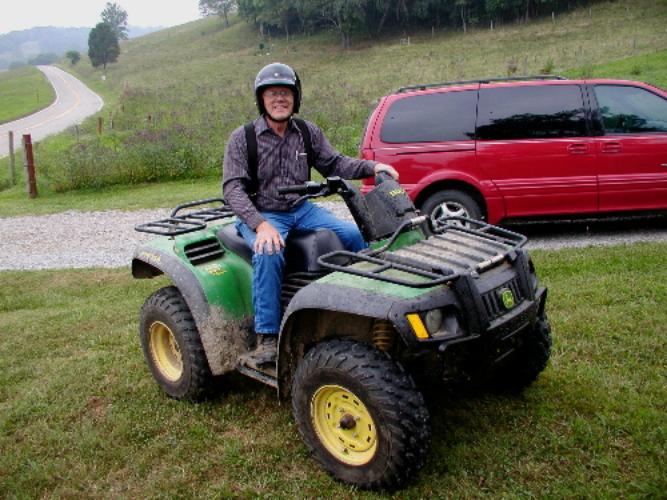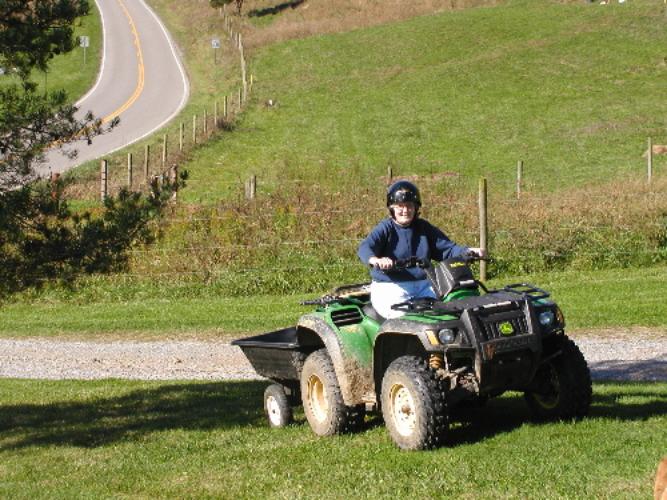
| Next Chapter | Previous Chapter | |
| Chapter 53: Borrowed Money | Contents | Chapter 51: Colorful Language |
….are a Japanese toy that are both a terror and a delight. A more technical term is “all terrain vehicle” or ATV. Sometimes one is called a “Japanese Quarter Horse.” That’s the way we use ours, like a horse. But you don’t have to feed them when you don’t use them, you are in complete control (at least they don’t bite or kick), and they don’t require daily attention.
Four wheelers are obviously an outgrowth of the motorcycle, which has been around for a long time. Like the motorcycle, they are relatively low cost, inexpensive to run, and dangerous. Three wheel devices with soft tires were used first, but they were very dangerous, because they turned over easily. The present design involves four tires that have about 5 or 6 pounds per square inch inflation pressure and a very large contact area with the ground. We bought our first, a used one, in 2001, when the price of gasoline went up to $1.65 a gallon the first time. We had no idea whether or when the price of gas would come back down. The idea was to have a quick, inexpensive way to look up cattle, go out to fix fence, etc. We also used the four wheeler to seed the roads in the woods used by the people taking out timber. Now we also use one for spraying brush in the pasture, when the brush is far apart.
For comparison, the ’94 Ford 350 truck I was using got about 8 miles to the gallon of gasoline. That Ford was a great truck, equipped with a bed that would lift two bales off the ground and carry them anywhere the truck would go, at road speed. The bed was a Hydra Bed made by Galien Ackerman in Sabetha, Kansas. The bed weighed 1600 pounds, and that is part of the reason the truck was so expensive to run. The engine was a 460 HP model, and the truck was the heaviest one ton truck Ford made, with a chassis designed to be used as a wrecker, an emergency car, or to pull a large trailer. The first year I had the truck I literally butted my way through snow drifts up hill to the strip job with a load of hay on the back to feed the cattle. The snow was too deep for the tractor I had then. Otherwise the truck wasn’t expensive to run. I called my Saturn car (which got 36 m. p. g.) the farm’s light truck.
Back to four wheelers. We had been hiring some of the cousins who had four wheelers at $100 a day to help round up the cattle when they were on the Sutton place. That cost also encouraged us to buy our own.
The worst thing about four wheelers is that they allow people to come in from far away, do things and escape so easily. Dane Williams had trouble with them about the 1980s. They were driven from Laurel Valley, about two miles around the strip bench above the West Fork river, much of it on John Stenger’s place, to a fence about thirty or forty yards long across the bench dividing Dane and John. At one end of this fence was the high wall, almost vertical, and the other was the spoil pile, which was as steep down from the level strip surface as it could be without sliding, what engineers call “the angle of repose.” The four wheelers were driven by junior high and high school kids.
They carried pliers and cut the fence and let Dane’s livestock out, as we say, “into the wilderness,” meaning a very large unfenced area. This is a tragedy for livestock owners, because cattle are hard to find and more difficult to get home. The coal company that stripped Dane’s farm left a steam shovel the kids liked to climb on. Of course, if someone had gotten hurt Dane would have been in trouble. Dane built a fence of junk cars, and they went over that. Then he made it two cars high, and they went over that, too. I don’t think he ever had any effective way to stop them.
More recently I have talked to people who would drive five miles on the old right-of-way where the B & O Railroad ran to get to the land owned by United Coals at McWhorter. United Coals has several hundred acres of mined-out land that is a favorite place to ride. When I put fence around some of it, I put small gates in for four wheelers and signs asking them to close the gates when they went through. That worked pretty well with the “clientele” there.
In the spring of 2001 we bought a used four-wheeler for $2000. The cousins from South Harrison were getting to be young men, and they had other interests, and were no longer available to help drive cattle.
(Illustraton 52-1)

The author on a good four wheeler
Also, my sons and son-in-law were more available to help do the herding.
We use the machine to check on what people are doing on the farm. Most people don’t recognize it, but in this era we are deep into multiple land use. Our family farms the surface, but other people buy and remove timber, still others hunt, paying us for the right, and the gas is leased, so the gas company and two different electric companies have rights-of-way. All this activity must be monitored. We have kept
(Illustration 52-2)

the gate at the coal road, which is the principal access to the farm, locked for fifteen years or so, to keep out casual trespassers. More serious intruders can go in anyway, thanks to the gas company lock on our gate. (Anyone who wants to can get a copy, unofficially, which is another aggravation with the Gas company.)
The four wheeler substantially changed the way we farm. The truck had been the fastest way to get to any spot on the farm, but the four wheeler could cut the time in less than half, and was more economical on gas. It was easier to get on and off the four-wheeler than to crawl out of the truck and back in. The only problem is….one really must be careful driving it! The truck you could roll over if you were careless, or you could get stuck. But the four-wheeler requires constant attention. It is not very stable from side to side, and little bumps at speed toss it around a lot. However, it will run on five gallons of gas for two or three days.
Our present four wheeler is a John Deere, which we like very well. It has an engine fan, which makes it ideal for the slow moving work we sometimes use it for. We have equipped it with an electrical connection in the rear, and pull a trailer with a sprayer on it, operated through the electrical connection. I also carry two hand sprayers, one for areas I can’t reach with the power sprayer, and one for basal spray, mixed with diesel, and a can of the basal spray. It is also used for yard work, as shown above.
We will never be without one again. They are so fast, convenient and economical they have a place on all but the smallest farms. And they are a pure delight to ride in good weather.
Aside I remember from the early forties sitting on the porch of Bill Horner’s Store, one of the general stores in Lost Creek and hearing this interesting story about a lady who lived in the past. I was very young, because the store, which sat diagonally across from the railroad station along the track, disappeared well before I was grown. The store was a general store with a large porch, and people, mostly men, sat around the edge of it or on chairs loafing and telling stories. I don’t know why we stopped, because Dad wasn’t inclined to loaf.
Rosco Curry, who was a very large man, one of a family of large, athletic people, claimed his mother could “prove she was a man” before she was sixteen. To “prove you were a man” in those days, he explained, meant you had to put both your feet in a peck measure (which kept them side by side) and pick up a sack with two bushels of wheat (120 pounds) and stand straight with it on your shoulder.
Few men could perform that feat today!
| Next Chapter | Previous Chapter | |
| Chapter 53: Borrowed Money | Contents | Chapter 51: Colorful Language |
Copyright © 1998, 2006, 2008, 2011 S. Tom Bond (stombond at hughes.net)